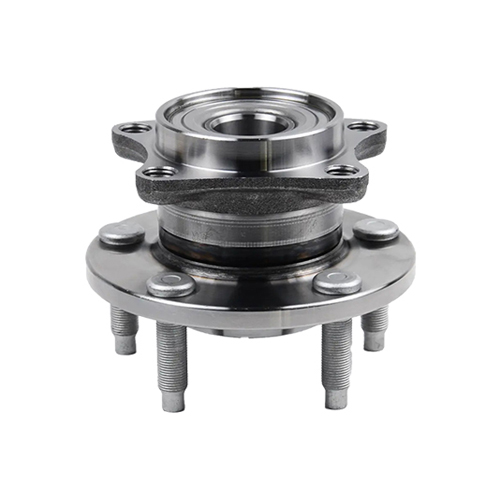
The main function of wheel hub bearings is to bear weight and provide precise guidance for the rotation of the wheel hub, which not only bears axial loads
It also bears radial loads and is a very important component
1、 Development History
Bearings for traditional automotive wheels
The traditional bearings for car wheels are composed of two sets of tapered roller bearings or ball bearings, and the safety of the bearings
Installation, oiling, sealing, and clearance adjustment are all carried out on the automotive production line. This structure makes it suitable for
Assembly difficulties, high costs, and poor reliability in car manufacturers, as well as the need to maintain bearings at repair points
Perform cleaning, oiling, and adjustment.
Its characteristics are:
Inconvenient to apply preload
The installation process is complex
Need to fill with lubricating grease
The hub bearing unit is developed on the basis of standard angular contact ball bearings and tapered roller bearings
Combining two sets of bearings as one, it has good assembly performance, can omit clearance adjustment, is lightweight, has a compact structure, and is capable of carrying
The advantages of large load capacity, the ability to pre install lubricating grease for sealed bearings, the omission of external hub seals, and the need for maintenance are also included,
It has been widely used in sedans and is gradually expanding its application in heavy-duty vehicles. Main Experience of Hub Bearing Unit
The following generations have been created:
1. First generation wheel hub bearings
The first generation wheel hub bearings are double row angular contact ball bearings or double row tapered bearings with integral outer rings and back to back inner rings
Roller bearings. To ensure that the preload after installation is within the specified range, the initial bearing clearance is pre-set in the car
There is no need to use spacers to adjust the preload on the assembly line. In addition, the hub bearing comes with its own sealing ring, saving labor
Steps for installing the sealing ring externally.
Compared to traditional models, the strengths of the first generation wheel hub bearing unit are:
Applying pre tightening is simple and reliable.
Easy installation.
No gaskets are required.
No need to replenish lubricating grease.
Compact structure.
Built in high-performance sealing ring.
2. Second generation wheel hub bearings
Compared with the first generation, the second generation wheel hub bearing with a flange on the outer ring is characterized by the assembly part
Less pieces, lighter weight, and convenient installation. The second generation wheel hub bearing outer ring is equipped with a flange plate, which is directly connected to the bolt
Connect to the suspension (inner circle rotating type), or install to the brake disc and steel ring (outer circle rotating type).
Compared to the first generation hub bearing unit, the second generation hub bearing unit has the following advantages:
Applying pre tightening is simpler and more reliable.
Easy installation.
There is no need to press in the steering knuckle.
3. Third generation wheel hub bearings
The third generation wheel hub bearings are connected to the outer ring of the suspension with a flange, and to the brake disc and steel ring with a flange
The inner circle of the Lan Pan is composed of phases. Unlike the second generation, the third generation wheel hub bearings integrate ABS sensors. Third generation wheel
Hub bearings generally use swing rolling technology to self-lock the half inner ring, and during the swing rolling process, the end of the hub shaft with a flange is affected
Apply axial load to deform it to secure the half inner ring. Compared to traditional nut tightening, this type of wheel hub shaft end rolling
The method has several advantages. For example, the third generation wheel hub bearings (not used for drive wheels) can help reduce volume and weight, similar to
Reduce costs when needed. The third generation wheel hub bearings (used for driving wheels) have been pre loaded before assembly into the car, therefore
Eliminated the step of adjusting the position of internal components. The third-generation wheel hub bearings using rolling technology are used for both
Both driving and non driving wheels have the above advantages.
Compared with the second generation hub bearing unit, the third generation hub bearing unit,
The best preload can be applied.
Easy installation.
High stiffness.
Easy to install anti-lock braking system (ABS) sensor
Type and internal structure of third-generation wheel hub bearings
1. ABS sensor built-in hub bearing unit (the hub bearing unit with built-in sensor located between two rows of raceways)
Hub bearing units must meet increasingly stringent requirements for lightweight, energy-saving, and modularity. Additionally, in order to
To ensure the safety and reliability of braking, anti-lock braking system (ABS) is becoming increasingly popular. Therefore, the market has a strong demand for built-in sensors
The demand for U-type wheel bearing units is also increasing. NSK relies on the unique high-tech and various
Strict bench test data has successfully developed high-quality small, lightweight, ABS sensor built-in wheels
Bearing unit.
Specialties
Fully utilizing the internal space of the bearing, making the structure more compact.
Sealing the sensor section has improved reliability.
It is possible to achieve the built-in sensor of the wheel hub bearing for the driving wheel.

